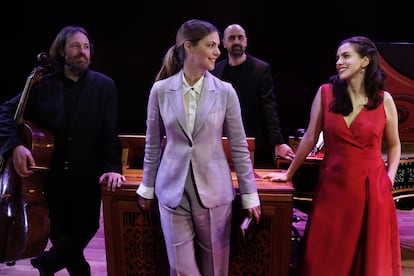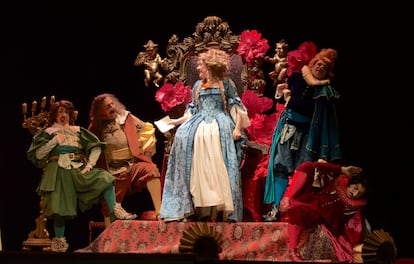The Almagro festival returns to the classic of classics, 'Fuenteovejuna,' directed by a woman for the first time.

The 48th edition of the Almagro International Classical Theatre Festival returns to the Fuenteovejuna stage, this time to open the show, which runs from July 3 to 27. This is the first time a woman, Rakel Camacho, has directed this classic. As is tradition, she does so with a previously unpublished work by the National Classical Theatre Company, founded in this city in La Mancha in 1986 and whose summer home is in Almagro.
Camacho creates a clarifying version of the work by writer and playwright María Folguera. They are two representatives of the new and daring voices in contemporary Spanish theater. “There are many possible starting points and many analogies in the play, but it always traverses those times in which injustice and violence go unpunished and seek to be perpetuated. Violence always generates violence,” maintains Camacho, known as a creator for moving in a dreamlike, surreal universe, with a stagecraft that transports us to other places through her theatrical ceremonies.
This drama, set in Fuenteovejuna (or Fuente Obejuna, or Fuente Ovejuna, or Fuenteobejuna, since all four place names are permitted), contains many profound interpretations that involve not only the rebellion of a people against and against power. Within this work, there is also a profound reflection on the end of the feudal era with its unjust rules, giving way to other times and customs about violence against women, tenderness, servility, justice, solidarity, internal struggles over political conflicts, revenge, unity, new forms of governance... And anyone who wants to can also find a love story there.
“But nothing can be romanticized here; all we have to do is denounce injustice and violence and reject it. In fact, I even focus on the hyperbolic to portray this atrocity, where the commander is corrupt and the people want to restructure the system. I haven't worked on the grotesque, but it is,” Camacho continues. And she does so with a lot of music, with elements and instruments that have a symbolic meaning and are part of the scenery. The director is clear that Lope writes cinema: “The action content of those verses is tremendous.”
All versions of the workPerhaps Lope de Vega's Fuenteovejuna is the Spanish Baroque classic that has endured, or enjoyed, depending on who dissected it, the most versions and interpretations. It was published in 1619, but the writer based it on the horrific and controversial events that occurred in that Cordoba town in 1476.
The 1903 production of the play at the Teatro Español was a version by Ramón María del Valle-Inclán, starring María Guerrero and Fernando Díaz de Mendoza (both grandparents of Fernando Fernán-Gómez, something they never acknowledged, because their mother was only an actress, and that meant little to them).
Another famous production was the one carried out by the La Barraca company between 1933 and 1935, to numerous towns, with a version and direction by Federico García Lorca, finally arriving in Madrid with actors Margarita Xirgu and Enrique Borrás. Cayetano Luca de Tena, José Tamayo, José Osuna, among others, were responsible for the most famous productions during the Franco regime.
Later came the productions of Marsillach with the CNTC and Emilio Hernández with the CAT (Andalusian Theatre Center). Max Aub produced his own version from exile. There were others that were considered Marxist at the time, and what the theatre researcher Sergio Adillo Rufo called the Brechtian "fuerovejunas ."
Already in the 21st century, Juan Mayorga, José Monleón, Emilio Hernández, and Alberto Conejero have adopted the work as their own. Also memorable were the USSR ballets, staged by Antonio Gades, and a filmed version by playwright Juan Guerrero Zamora.
The town's inhabitants have also been protagonists of their own story since 1935. Director Manuel Canseco, one of the most important names in the classical genre , was one of the last to direct the production from the town. In 2013, he recruited actors from Meliá (the town's nickname) and changed the roles traditionally assigned to them. "It helped eliminate any acquired vices, because I still maintain that verse is rhythm, and if it becomes prose, we're in trouble," explains the playwright. "Everything turned out wonderfully; we added new sets and wonderful flamenco music, singing the ballad of Fuenteovejuna, which sums up the whole story."
Each production has its own interpretation of a text that Lope de Vega himself allowed. The directors, and now a female director as well, can justify and defend, however they see fit, the violent and evil Commendatore, the humiliated Laurencia, or the drama's unequivocal character: the inhabitants of Fuente Obejuna.

Before the premiere of this production, the Corral de Comedias Award ceremony will be held, which this year went to dancer Cristina Hoyos. From there, the festival unfolds throughout the city of La Mancha , specifically through the seven emblematic spaces where dance, baroque, Sephardic, and flamenco music, circus, premieres, exhibitions, and gastronomic tours are presented. There are audiovisual installations such as the one called Genias, where you can enjoy the verses of great actresses. This is in addition to the exquisite collection held at the National Museum of Performing Arts, which has been expanded this year.

The Morboria group turns 40 and will celebrate with the premiere of Rojas Zorrilla's What Women Are , a major exhibition, and the festival will pay tribute to her. The program of classics is completed with four other works by Lope de Vega, Calderón, Cervantes, Tirso, Molière, Juan Ruiz de Alarcón, María de Zayas, Ana Caro, Shakespeare, Feliciana Enríquez de Guzmán, Saint Teresa, Saint John... And a slightly more contemporary classic, Rafael Álvarez 's The Witch.
EL PAÍS





